

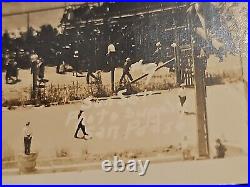

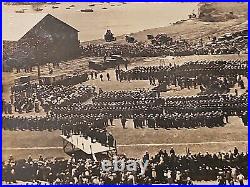

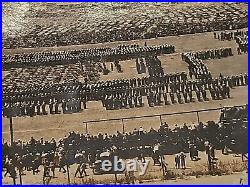
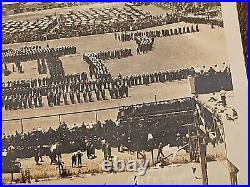
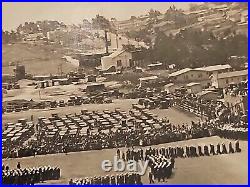
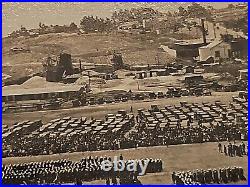

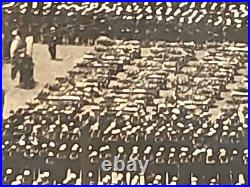




1924 Photo Funeral Procession USS MISSISSIPPI BB-41 Turret Explosion 48 KIA 5×7. While conducting gunnery practice off San Pedro on 12 June 1924, there was an explosion in her forward superfiring Gun Turret No. The resulting fire asphyxiated 44 members of the turret crew. Upon returning to port the gunpowder that was still in Gun No. 5, the remaining gun in the turret, exploded and killed four members of the rescue team. This was, at the time, the deadliest peace-time disaster in the Navy’s history. The USS Mississippi is home to one of the most intriguing naval coincidences of all time. Built while America was a neutral party in World War I, Mississippi sailed into the atomic age and later served as a massive test platform for surface-to-air missiles. Despite her forty years of service, Mississippi was bound to tragedy, experiencing two major accidents in the same turret, in the same gun, twenty years apart. On June 12, 1924, Mississippi found herself off the coast of California conducting gun trials. The 14-inch/50 caliber gun was plagued with technical issues, a major problem considering it was the primary armament on the majority of serving U. On the eighth salvo, turret two, gun two suffered a rare flare back. The four powder bags inserted into the breech, totaling 470 pounds of explosive powder, caught fire and ignited other bags waiting to be loaded. Forty-eight sailors were killed, and only one of the sailors manning the turret survived. Nearly twenty years-and a major refit later-the USS Mississippi went to war in the Pacific. In 1943, the big battleship was off the coast of Makin Island, providing naval gunfire support to a landing force preparing to secure the island. Suddenly, in the midst of the barrage, smoke and gas erupted from the rangefinders on either side of the number two turret. Incredibly it had happened again: in their haste to lay down a rain of shells on the Japanese, the gunners of number two turret had apparently experienced yet another flare back. Debris from firing the big guns had again ignited powder bags, causing the same accident and the same damage. Forty-two sailors were killed and another sixteen wounded. The battleship’s three remaining turrets continued firing until the naval support phase of the invasion had ended.



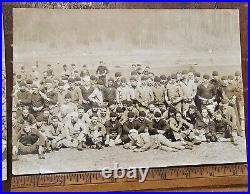
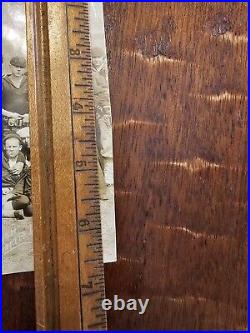
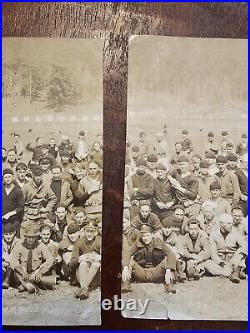
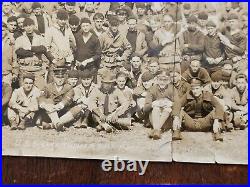

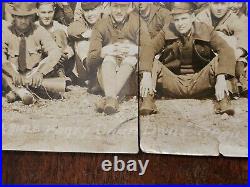
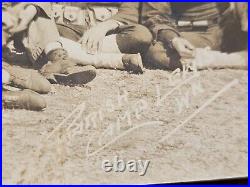
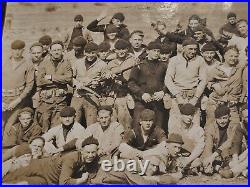
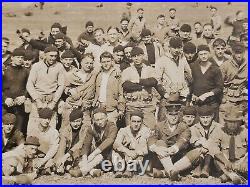

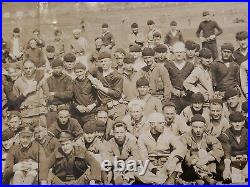
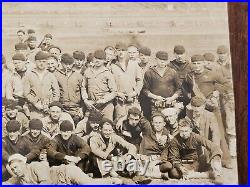
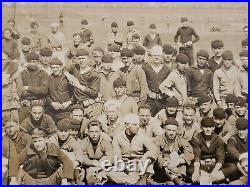
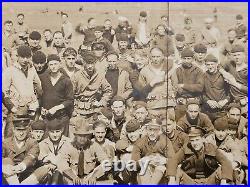
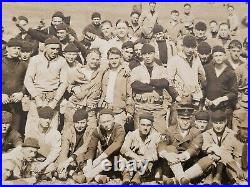
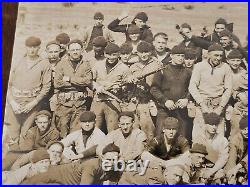

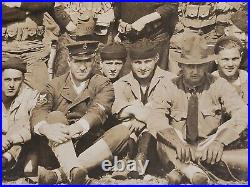
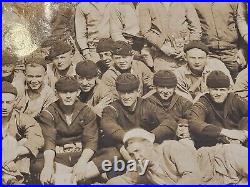


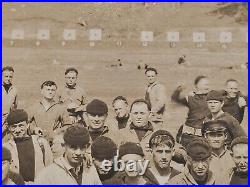
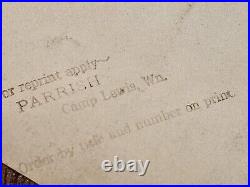

1923 PHOTO USS OKLAHOMA RIFLE PARTY FOOT LONG 2-PIECE 19 x 6 1/2 CAMP LEWIS. Amazing photo – USS OKLAHOMA BB-37 Crew st a rifle range – captioned “USS OKLAHOMA RIFLE PARTY CAMP LEWIS APRIL 1923″. Photo is in two parts with each being 9 1/2 x 6 1/2 for a total size of 19″ x 6 1/2″. USS Oklahoma (BB-37) was a Nevada-class battleship built by the New York Shipbuilding Corporation for the United States Navy, notable for being the first American class of oil-burning dreadnoughts. After the war, she served in both the United States Battle Fleet and Scouting Fleet. Oklahoma was modernized between 1927 and 1929. In 1936, she rescued American citizens and refugees from the Spanish Civil War. On returning to the West Coast in August of the same year, Oklahoma spent the rest of her service in the Pacific. Some sailors inside escaped when rescuers drilled holes and opened hatches to rescue them. Unlike most of the other battleships that were recovered following Pearl Harbor, Oklahoma was too damaged to return to duty.


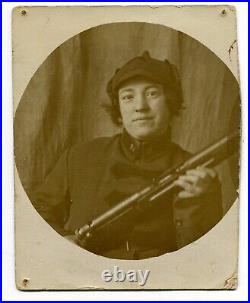
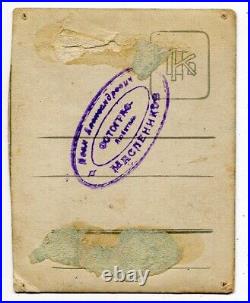

On the collar of the buttonholes on which there is the abbreviation “?? ” – “Military Academy”. The Academy of the Red Army is a higher educational institution that trained the highest command staff of the Red Army. Studying girls in it is an extremely rare occurrence! Size about 7 x 9 cm. On the back – amateur photographer stamp. 100% OLD USSR ORIGINAL! Very good for collection! PLEASE, SEE THE PICTURES. Please see my other items, there are many interesting things!! Have a good shopping!


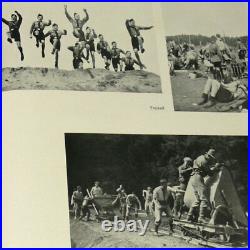

310 very rare b&w photos. Published by Folk House. Germany and it’s evolution of culture. Hardcover in Full Linen / Cloth. Good exterior and good interior condition.


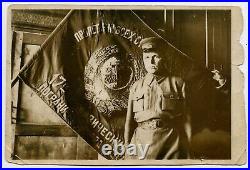


We offer you a rare collection photograph 17th border detachment of the NKVD USSR. January 25, 1925, the date of establishment of the 17th border detachment of the OGPU. The place of deployment of the detachment is the city of Timkovichi, Kopyl district, Minsk region. February 14, 1936 for heroic service in the protection of the western borders of the USSR, the 17th border detachment of the NKVD was awarded the Order of the Red Banner. On January 17, 1939, as a result of the annexation of the Western region of Belarus to the USSR, the 17th Red Banner Timkovichi border detachment of the NKVD of the USSR was redeployed to the city of Brest, where it took under protection a section of the State border along the Western Bug River with a length of 182 km. On June 22, 1941, the 17th border detachment of the NKVD took the first battle in the Brest Fortress, the legendary defense of which for several weeks went down in the history of World War II. The photo shows one of the leaders (commanders) of the OGPU-NKVD border detachment – D. Proletarians of all countries unite! 17th Timkovy border detachment of the OGPU (NKVD). Caption on the back of the photo. In memory of the 17th border detachment of the OGPU, D. Size about 8 x 11,5 cm. 100% OLD USSR ORIGINAL! Very good for collection! PLEASE, SEE THE PICTURES. Please see my other items, there are many interesting things!! Have a good shopping!


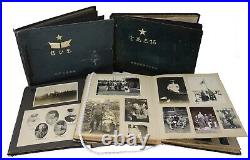
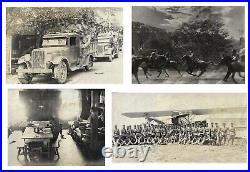
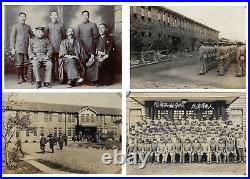
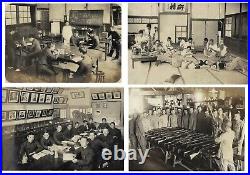
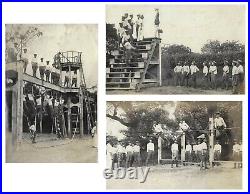
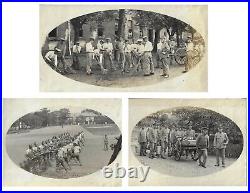
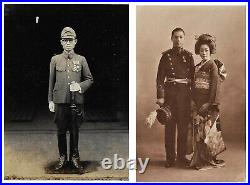
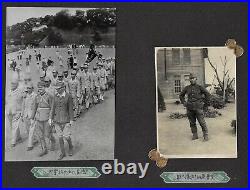

Four Photograph Albums Documenting Training and Service in the Imperial Japanese Army in the Interwar Years. Description: Four photograph albums containing a total of 558 mounted images documenting military training and service in Japan in 1920s and 30s, all in very good condition. Although we acquired these albums together, they appear to have belonged to different people. Most, if not all, were officers. One album has handwritten captions, the others do not, but do have some group photographs with captions in the negative. Two identity documents are tipped in to one album that, we are told, are for people with the family names Yokoo and Hayashi. During the interwar years, Japanese culture was pervaded by the conviction that a strong military was the solution to most problems, foreign and domestic. The Army enjoyed considerable independence from the civilian government, and various factions within the military played a major role in directing the country’s foreign policy. As described by historian David Hunter-Chester in The Culture of Military Organizations, (Cambridge, 2019) the Imperial Japanese Army’s organizational culture produced tough, proficient, and courageous soldiers. These albums reflect great pride in military service, with numerous images of their subjects in dress uniform (singly and in groups) and engaged in military exercises, including bayonet training, firing machine guns, field and parade drills, physical fitness (ropes course, gymnastics), equestrian training, cleaning and assembly of weapons, and more. There are also images of soldiers in the classroom, at leisure sporting events, sumo, at a public bath, etc. , and at special events and celebrations-the latter characterized by an abundance of Japanese and Imperial Army flags. These albums reflect an ethos that was soon to vanish. The military culture of pride in excellence, according to Hunter-Chester, left it unable to deal with military losses; it was a culture that prized reputation over public honesty, ritualized death and placed its own judgment above question. According to its own creed, the [Army] should have’done its utmost to protect the state. Instead its soldiers are remembered in Japan and much of the world as’beasts. See our other Asia. Condition Descriptions Defined: We grade our books and dust jackets using the traditional language of the antiquarian book trade. In brief: Fine is the highest grade and means essentially as new, without visible faults or defects; Near Fine means approaching fine, but with one or more very minor defects or faults, which will be noted; Very Good means the book shows some general (but not too offensive) signs of wear and use, which will be noted; Good means the book is complete and intact, but has more wear or some internal markings. Any ex-library book will be graded no higher than Good, even if it is otherwise a very nice copy. Again, all flaws will be noted. We rarely offer any books in Fair or Poor condition, but if we do, the reasons for the grade will be evident from the photo(s) and description. Please notify us in advance of any return. About us: Walkabout Books is a member of the Antiquarian Booksellers Association of America (ABAA) and the Independent Online Booksellers Association (IOBA).


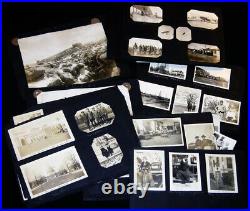
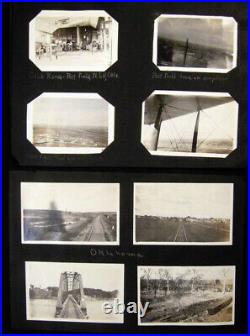

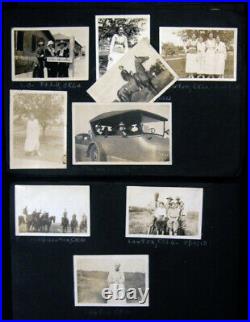
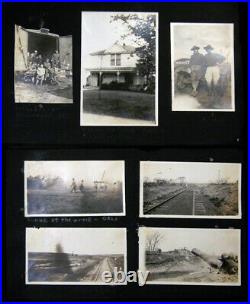

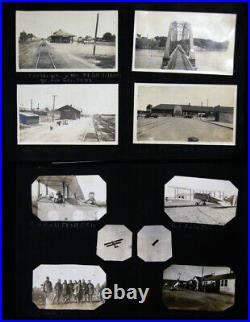
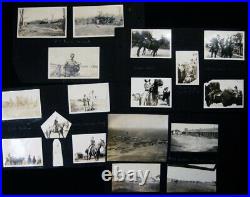

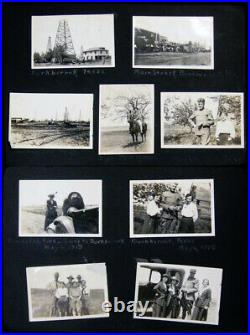
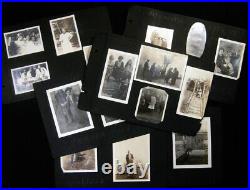
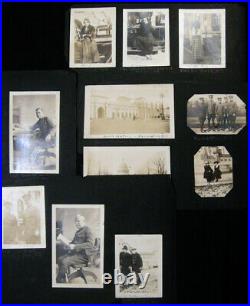

[027793] (Americana – 20th Century – Photography – Military – WWI – Oklahoma – Washington DC). 1918 -1920 Military & Social Visual History: Photograph Album Oklahoma & Western U. Washington DC; Wernersville PA & Others. Over 100 are of Oklahoma and surrounds: Fort Sill, the barracks and grounds, candid shots of the personnel, the post airfield, aircraft, fliers, hangars and including an aerial view by the Aerial Photographic Section; horses and riders; a couple of Native Americans; Chickasaw & Mustang train station buildings; Knights of Columbus Home in OK city; several images of a wreck of a tank truck; one of nurses arriving via train; several of women visitors & with their base personnel friends during social activities. About 90 are personal photos & tourist views of Washington, DC including small commercially-printed imagery; several of military personnel, including officers. One image of a woman entering an automobile is identified below, The Colonel’s Packard & I Wash. The car has the military identification of the quartermaster corps. With various other candid military & civilian portraits taken in that city; also architectural views of Federal buildings, homes and images taken from altitude. About 25 images were taken in Denver and on a Pikes Peak CO excursion; another 15 from Texas, the border area and Burkburnnet. Another group of about 30 images are identified as taken in the Wernersville PA area, mostly of family members; these are not identified. The balance of the photographs are of family and friends in various places. Photos vary in size, from 2″ x 3″ to 6″ x 8″; the album pages approx. 7″ x 10″ size. The leaves are disbound, with only the bottom cover here. Some of the images are detached from the pages and loose; these may match some of the open, identified spaces on the leaves. Some images with fading and edge-wear or crinkling; generally the photos were well-taken and are in good to very good condition. This item is in the category “Collectibles\Militaria\1919-38\Original Period Items”. The seller is “475today” and is located in this country: US. This item can be shipped worldwide.
- Original/Reproduction: Original
- Theme: Militaria
- Time Period Manufactured: 1919-38
- Country/Region of Manufacture: United States


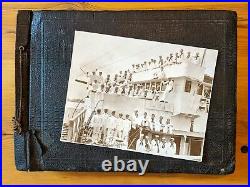
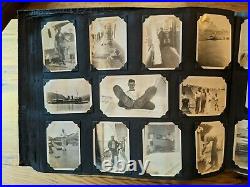



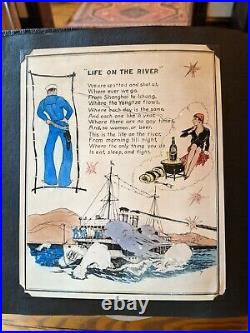
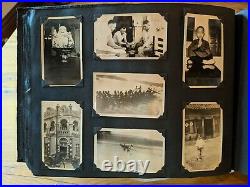
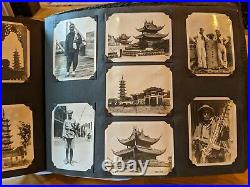
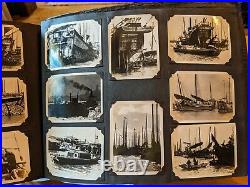
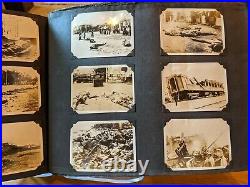


An outstanding US Navy or Marine sailor’s photo album. A singular production of more than 500 photographs taken or acquired while assigned to the Yangtze River gunboat USS Oahu in the early-1930’s. The album measures approximately 15 x 11. It is string bound and its flexible board panels are covered in a faux-reptile skin cloth. There are a bit more than 500 photographs (I count 513) mounted to the rectos and versos of 37 black paper leaves, loosely fit into dry corner mounts (and easily and safely removable). The majority of photos, about 350 of them, appear to be original snapshots captured by the soldier. They range in size from about 3 1/2″ x 2 1/2″ to 5 1/2″ x 3 1/2″. This section is in the front and separated by about a dozen blank leaves, then proceeded by about 160 more photographs which appear to be a blend of commercial or souvenir prints and photos captured by a more skilled photographer. Most of these measure approximately 4″ x 3″ and there are some phenomenal cultural images among them. There are also about 8 enlarged photographs, approximately 8″ x 10, ” including the excellent identified and dated photograph of the Oahu crew shown here in the first image. It is dated 1932 and is the only dated photo in the album, though the balance of contents seem firmly within the same timeframe. There is no notation to any of the album pages and we’ve carefully removed several of the prints and haven’t found any notations to print versos either. This is fresh from a local, multi-generational estate and is as-found by me ; nothing has been added or removed. I strongly suspect the soldier was from the St. This is a significant photographic document of the Yangtze Patrol captured during an important time immediately preceding the outbreak of World War II in the Pacific. I have additional images of the album available. Please send along any questions and thanks for looking. The item “Photo Album USS OAHU Yangtze River Gunboat US Navy Sailor China Shanghai 1930s” is in sale since Monday, July 5, 2021. This item is in the category “Collectibles\Photographic Images\Vintage & Antique (Pre-1940)\Photo Albums”. The seller is “full-cycled” and is located in Saint Louis, Missouri. This item can be shipped to United States.
- Region of Origin: US
- Modified Item: No
- Framing: Unframed
- Country/Region of Manufacture: China
- Size Type/Largest Dimension: Small (Up to 7″)
- Listed By: Dealer or Reseller
- Date of Creation: 1930-1939
- Color: Black & White
- Photo Type: Snapshot
- Subject: Military & Political
- Time Period Manufactured: Vintage & Antique (Pre-1940)
- Original/Reprint: Original Print

Incoming search terms:

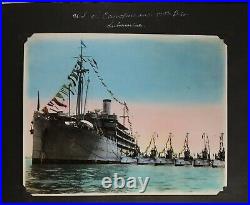
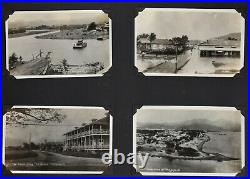
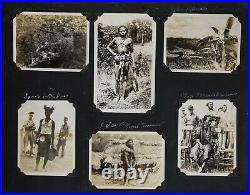


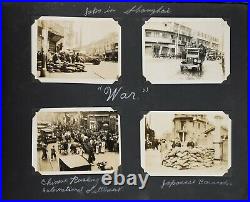
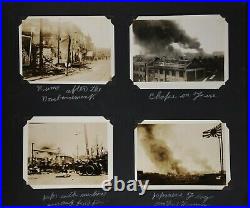
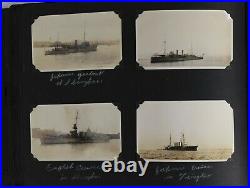

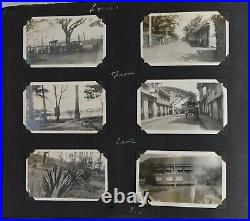
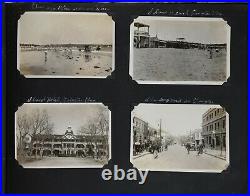


Photograph album of Anderson Banks Lester, filled approximately 525 photographs (most snapshots, but 16 large format) documenting his time stationed on the submarine tender U. Canopus in China and the Philippines in the 1930s. The album itself measures 11 x 14 inches and is about two inches thick. It is a commercially produced album marketed specifically to military men, with a printed title page headed “My Oriental Album, ” on which the owner signs his name. It includes 10 are large, hand-colored photographs ca. 7 x 9 to 8 x 10 and six large b/w photos. The remainder are a range of snapshot sizes (b/w), with most in the range of 2.5 x 4.25 to 3.25 x 5.75 inches. Condition of the album is very good, but there are several pages with photos missing. PLEASE SCROLL DOWN to see many additional images (beyond the 12 posted above). The item “Photo Album USS CANOPUS 1932 China & Philippines Asiatic Fleet Shangai Bombing” is in sale since Monday, December 14, 2020. This item is in the category “Collectibles\Photographic Images\Vintage & Antique (Pre-1940)\Photo Albums”. The seller is “colorfulstuff” and is located in Chehalis, Washington. This item can be shipped worldwide.
- Listed By: Dealer or Reseller
- Date of Creation: 1920-1929
- Original/Reprint: Original Print

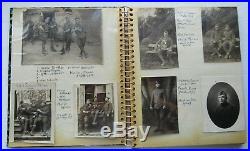
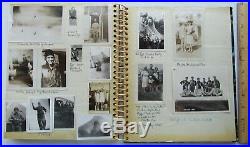
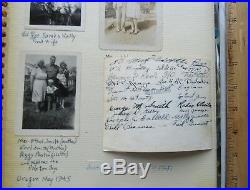


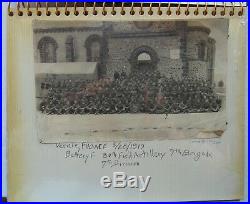
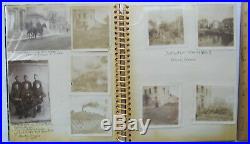
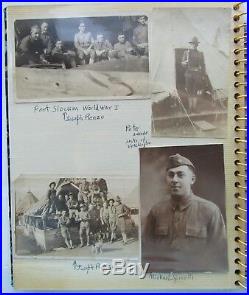

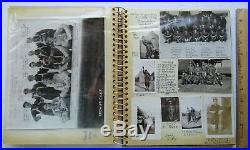
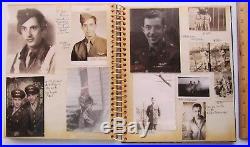
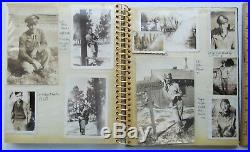

NOTE: not sure why.. But some of the words in the description was cut off. If you cannot view the words.. You copy and paste part of the description you could not read.. And when you paste it.. You will be able to read it. Sorry for the inconvenience. There are approx 75 photos maybe more. Photo Album with WWI, WWII and Korea c 1919 thru 1940s. Photos show Philip Renzo in WWi photos, Peter P. Renzo in WWII photos and Joseph Renzo.. Renzo was an Aviation Cadet from April 19, 1943 to July 1943 and became an officer in the Air Corps from July 1943 until 1945. Upon service as an officer, he was assigned to the 781st Bomber Squadron of the 465th Bomber Group (heavy). The 465th played a key role in the invasion of southern France in 1944 and saw distinguished service in areas such as Italy. Germany, Central Europe and the Balkans. He recieved many awards which include the Air Medal with one oak leaf cluster. WWII Honorable Service Lapel, WWII Victory Metal, American Campaign Metal, and the European-African-Middle Eastern. Campaign medal with 1 bronze star. Second Lieutenant Peter P. Renzo was killed in action on March 14, 1945. He was buried at the Lorraine American Cemetery in St. One of the photos that is in the album.. This photo can also be viewed on the web with the history. If you would like the www address.. Please let me know and I will send it you. This is the information that is on the web. This is the photo. The day B-24 Liberator White Y didnt come home. Tens crews launched their B-24 Liberators into the dark, cold morning air on March 14, 1945 from. William Bradley flew next to Lt. Who commanded the aircraft as they headed to bomb the Marshaling Yard at Nove Zamky, Hungary. Their crew of twelve included two navigators, a radar nav, bombardier. Engineer, radio operator, and four gunners. The overall mission was deemed a success, but the only man to survive on Martzs crew had a dramatic tale to tell. Memorial Day, where we remember those who have died in battle, seemed an appropriate time to tell a story about a distant Parks relative, Lt. William Bradley, who died in World War II. My husband had become particularly interested in him (a cousin once removed) after he discovered William and his brother were fellow Georgia Tech yellow jackets. The oldest brother graduated in 1941, and William entered that year as a freshman. William left college two years later in 1943, as many young men did, to go to war. He was commissioned a 2LT in the Army Air Corp in 1943 and assigned to the 781st Bomb Squadron, 465 Bomb Group, 15th Air Force, flying B-24 Liberators. The the unit trained at McCook field Nebraska and operated until the war in Europe ended in 1945. The only man to survive William Bradleys last flight was engineer, T/Sgt. Beeson, who told his story about the fateful flight. Today that story and many others are printed in a booklet. Of the units history published by the 781. Below is an abbreviated version of that event told by Beeson in 1987. The bombing run to the marshaling yard was not different than many others. The flak, while not as heavy as theyd encountered before, had pegged the formations location. The crew successfully unloaded their bombs over the target and were preparing to turn and head home. The tail gunner reported flak following their line of flight, bursting closer and closer. An explosion shook their craft. Fire burst on the pilots side as flak came up from underneath his seat. A single glance revealed Martz had died. The last thing Beeson saw on the flight. Deck as he hit the bailout alarm was Lt. Bradley attempting to control the damaged aircraft. Beeson grabbed his chute and dropped into the bomb bay where the bombardier joined. Him with chute in hand. The plane lurched, and Beeson fell out, facing up where he could see the plane above going around and around. He never saw where it crashed. Reported three or four chutes leaving the plane, but the unfriendly Hungarians below with their town in flames likely left them no chance for survival. Beeson lived to tell the tale because. He was rescued from the villagers hands by a German soldier. So many people have died in WWII and other wars our nation has fought. I appreciate their sacrifice to allow my friends and family to live in this great country. Some of the other photos in the book are. Photo shows WW11 – crew 29/ C. Photo shows Vernie, France, 5/28/1919, Battery F, 8th Field Artillery. 7th Brigade, 7th Division. 5 3/4 by approx. Some photos show the Destruction of WWI, Vernia, France. 3 3/4 by approx. 5 3/4 also shows Crew 29 C. Has the autographs in the back of the photo (as pictured). Some photos in WWI pages shows some who was in the Machine Gun Squad. Photo shows Lt Peter Renzo graduation Bombardier San Angelo, Texas, 5/22/44. Overall condition of album is good. INVENTORY BEING ADDED DAILY SO COME BACK OFTEN. ALWAYS WALK AWAY WITH A DEAL. IF THERE IS A PROBLEM PLEASE LET ME KNOW SINCE MY SYSTEM AUTOMATICLLY OPENS UP A UNPAID ITEM CASE AFTER 5 DAYS. Be sure to add me to your. The item “Photo Album WW1 WW2 & Korea c 1919 1940s with Bombardier Squad ++ WWI WWII” is in sale since Tuesday, February 19, 2019. This item is in the category “Collectibles\Photographic Images\Vintage & Antique (Pre-1940)\Photo Albums”. The seller is “lastcenturyjunk” and is located in East Meadow, New York. This item can be shipped to United States.
- Date of Creation: 1900-1909
- Original/Reprint: Original Print
- Subject: Historic & Vintage
- Listed By: Dealer or Reseller
- Photo Type: Snapshot
- Modified Item: No
- Color: Black & White












































































































